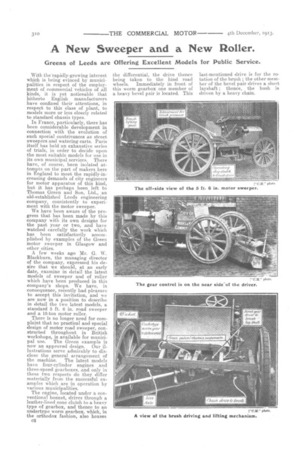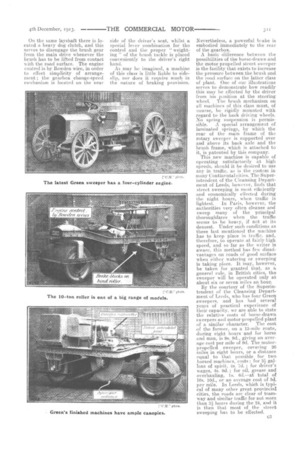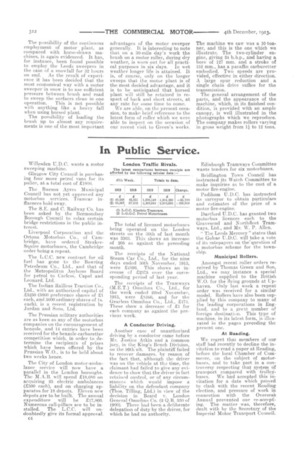A New Sweeper and a New Roller.
Page 10

Page 11

Page 12

If you've noticed an error in this article please click here to report it so we can fix it.
Greens of Leeds are Offering Excellent Models for Public Service.
With the rapidly-growing interest which is being evinced by MUMC1palities in respect of the employment of commercial vehicles of all kinds, it is yet noticeable that hitherto English manufacturers have confined their attentions, in respect to this class of plant, to models more or less closely related to standard chassis types.
In France, particularly, there has been considerable development in connection with the evolution of such special contrivances as street sweepers and watering carts. Paris itself has held an exhaustive series of trials, in order to decide upon the most suitable models for use in its own municipal services. There have, of course, been isolated attempts on. the part of makers here in England to meet the rapidly-increasing demands of city engineers for motor apparatus of this kind, but it has perhaps been left to Thomas Green and Son, Ltd., an old-established Leeds engineering company, consistently to experiment with the motor sweeper.
We have been aware of the progress that has been made by this company with its own designs for the past year or two, and have watched carefully the work which has been satisfactorily accomplished by examples of the Green motor sweeper in Glasgow and other cities.
A few weeks ago Mr. G. W. Blackburn, the managing director of the company, expressed his desire that we should, at an early date, examine in detail the latest models of sweeper and of roller which have been produced in this company's shops. We have, in consequence, recently had pleasure to accept this invitation, and we are now in a position to describe in detail the two latest models, a standard 5 ft. 6 in. road sweeper and a 10-ton motor roller.
There is no longer need for complaint that no practical and special design of motor road sweeper, constructed throughout in British workshops, is available for municipal use. The Green example is now an approved design. Our illustrations serve admirably to disclose the general arrangement of the machine. The latest models have four-cylinder engines and three-speed gearboxes, and only in these two respects do they differ materially from the successful examples which are in operation by various municipalities.
The engine, located under a conventional bonnet, drives through a leather-lined cone clutch to a heavy type of gearbox, and thence to an undert3rpe worm gearbox, which, in the orthodox fashion, also houses
c2 the differential, the drive thence being taken to the hind road wheels. Immediately in front of this worm gearbox one member of a heavy bevel pair is located. This
last-mentioned drive is for the rotation of the brush ; the other member of the bevel pair drives a short layshaft ; thence, the bush is driven by a heavy chain.
On the same layshaft there is located a heavy dog clutch, and this serves to disengage the brush gear born the main drive whenever the brush has to be lifted from contact with the road surface. The engine control is by Bowden wire, in order to effect simplicity of arrangement ; the gearbox change-speed mechanism is located on the near side of the driver's seat, whilst a special lever combination for the control and the proper " weighting " of the brush tackle is placed conveniently to the driver's right hand.
As may be imagined, a machine of this class is little liable to sideslip, nor does it require much in the nature of braking provision. Nevertheless, a powerful brake is embodied immediately to the rear of the gearbox.
A _basic -difference between the possibilities of the horse-drawn and the motor-propelled street sweeper is the facility that exists to increase the pressure between the brush and the road surface on the latter class of plant. One of our illustrations serves to demonstrate how readily this may be effected by the driver from his pDsition at the steering wheel. The brush mech.anisiu on all machines of this class must, of course, be rigidly mounted with regard to the back driving wheels. No spring suspension is permis sible. A special arrangement of laminated springs, by which the rear of the main frame of the rotary sweeper is supported over and above its back axle and the brush frame, which is attached to it, is patented by this company. This new machine is capable of operating satisfactorily at high speeds, should it be desired to use any in traffic, as is the custom in many Continental cities. The Superintendent of the Cleansing Department of Leeds, however, finds that street sweeping is most efficiently and economically effected during the night. hours, when traffic is
lightest. In Paris, however, the authorities very often cle.anse and sweep many of the principal thoroughfares when the traffic seems to be heavy, if not at its densest. Under such conditions as these last mentioned the machine has to keep place in traffic, and, therefore, to operate at fairly-high speed, and so far as the writer is aware, this method has few disadvantages on roads of good surface when either watering or sweeping is taking place. It May, however, be taken for granted that, as a general rule, in British cities, the sweeper will be operated only at about six or seven miles an hour.
By the courtesy of the Superintendent of the Cleansing Department of Leeds, who has four Green sweepers, and has had several years of practical experience of their capacity, we are able to state the relative costs of horse-drawn sweepers and motor-propelled plant
of a similar character. The cost of the former, on a 13-mile route, during eight hours and for horse and man, is 9s. 9d., giving an .average cost per mile of 9d. The motorpropelled sweeper, covering 26 miles in eight hours, or a. distance equal to that possible for two horsed machines, costs : for V,gallons of spirit, 4s. 7d. ; for driver's wages, 4s. d. ; for oil, grease and overhauling, is. 6d,—at total of 10s. 10d., or an average cost of 5d. per mile. In Leeds, which is typical of many other great provincial cities, the roads are clear of tramway and similar traffic for not more than 3i hours during the 24, and it is then that most of the street sweeping has to be effected.
The possibility of the continuous employment of motor plant, as compared with horse-drawn machines, is again evidenced. It has, for instance, been found possible to employ the Leeds sweepers in the case of a snowfall for 32 hours
on end. As the result of experience it has been decided that the most economical way with a motor sweeper in snow is to use sufficient pressure between brush and road to sweep the surfaces dean in one
operation. This is not possible with anything like a heavy fall when using horsed plant. The possibility of loading the brush up to almost any require. meets is one of the most important advantages of the motor sweeper I
generally. t is interesting to note that on a 30-mile day's work the brush on a motor roller, during dry weather, is worn out for all practical purposes in six days. In wet weather longer life is attained. It is, of course, only on the longer sweeps that the motor plant is of the most decided advantage, and it is to be anticipated that horsed plant will still be retained in respect of hack and short streets, at any rate for some time to come.
We are able, on the present occasion, to make brief reference to the latest form of roller which we were able to inspect on the occasion of our recent visit to Green's works. The machine we saw was a 10-tonner, and this is the one which we illustrate. The two-cylinder engine, giving 24 b.h.p., and having a bore of 127 mm. and a. stroke of 152 ram., has a paraffin carburetter embodied. Two speeds are provided, effective in either direction. A large spur reduction and a single chain drive suffice for the transmission.
The general arrangement of the parts, and the appearance of the machine, which, in its finished condition, is provided with an ample canopy, is well illustrated in the photographs which we reproduce. The company makes rollers varying in gross weight from 1i to 12 tons.
























